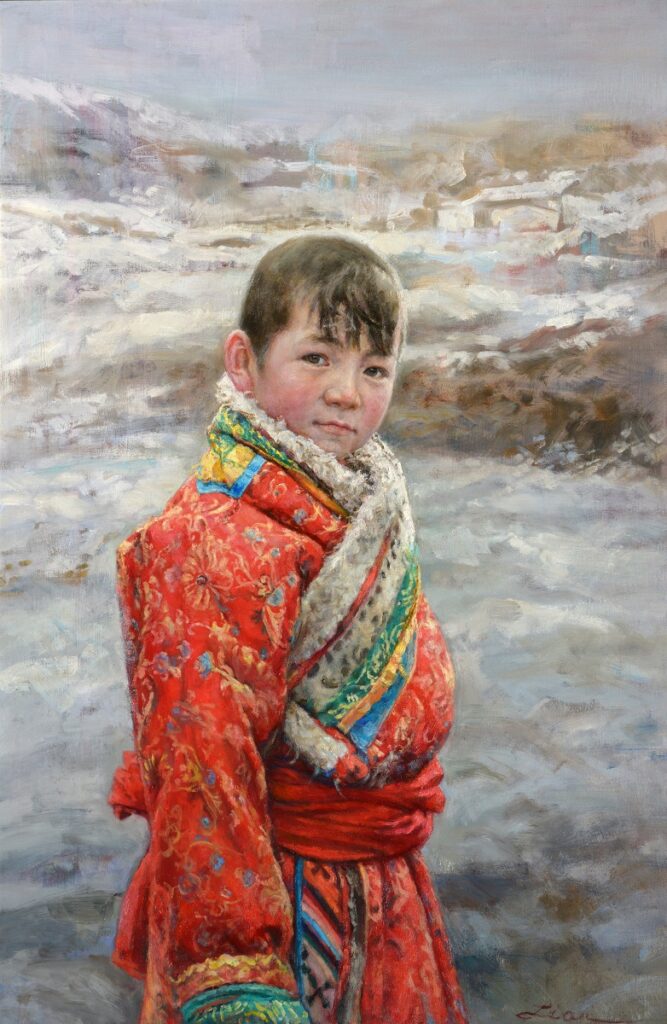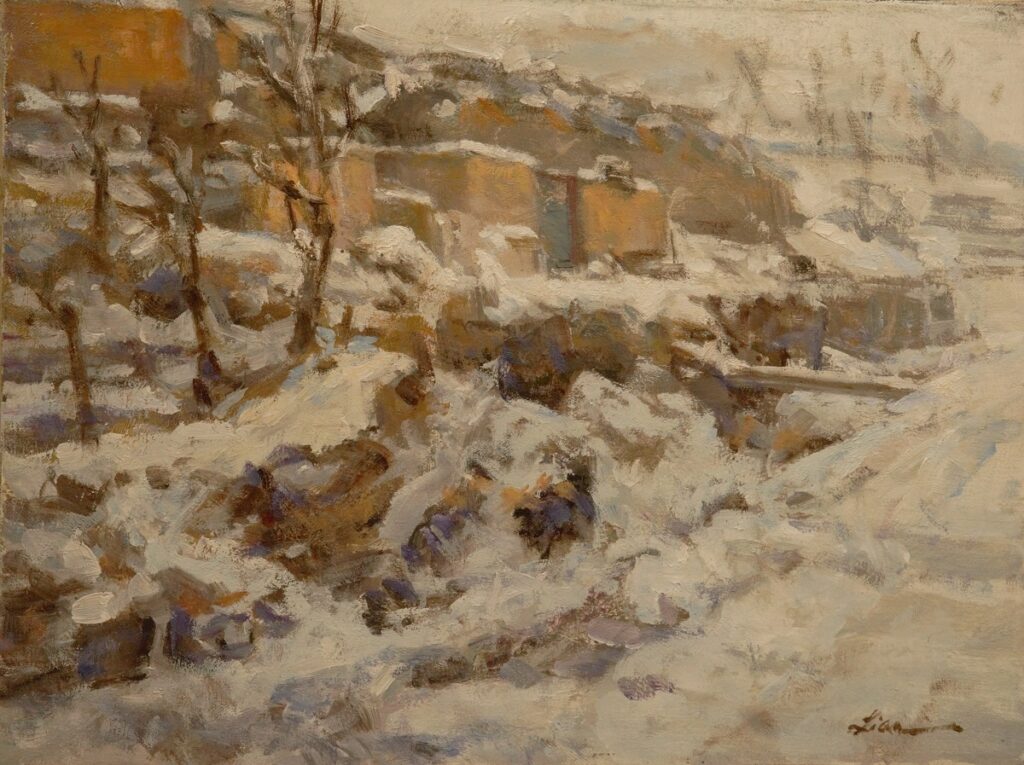Classical, impressionist, and hyperrealist works are all now considered “traditional” painting. I am a member of this field who has been working tirelessly and persistently to hone my passion, which is somewhat of an inheritance from my father. I never stop painting because I want to create the perfect artwork. Although the process is mixed with distress and excitement, frustration and happiness, I never grow tired of it.

(I wished to express a sense of calm and peacefulness while highlighting interests in the hair, skin tone and scarf.)
The standards for what is considered a “good painting” can incorporate many diverse styles and concepts. And while I appreciate various styles, in terms of personal pursuit, I prefer works which are subtle and concise, yet vivid and insightful, hiding their ingenuity and skill in simplicity. The “hidden edge” in East Asian aesthetics is something that I greatly appreciate. For example, in calligraphy and painting, in order to make the work more meaningful, the edge of the brush stokes will be intentionally reduced, so all the lines and colors express the artistic conception of the work with grace and restraint.

(My goal was to reflect the child’s demeanor under the simple contrast of colors.)
Classical religious painting is a perfect example of this philosophy. I believe it was less influenced by the commercial market and instead created by the artists to show their faith and reverence, thus the sense of meaning and authenticity are more strongly reflected in those works. I have always viewed such masterpieces with admiration, trying to learn from them, and comprehend their true meaning.

(I seized the moment to express the youthful vigor of the girl using loose brushstrokes.)
It is undeniable that artists do not live in a vacuum and need financial support. Often, we consciously or unconsciously meet the needs of various markets by bringing commercial influences into our paintings, such as the over-emphasis of bold and exaggerated brush strokes, tones, over-thickened pigment stacks, and over-enhanced color, light, and other surface effects, which I believe weaken the artistry of the work. I have personally experienced painting such works to please the market for the sake of livelihood 25 years ago.

(I strove to emphasize three-dimensionality and a sense of light.)
Over my many years of teaching and judging art, I not only pay attention to the basic elements of the painting, such as space, perspective, color, composition and overall processing, but also to the style level of the work. The style level reflects a person’s understanding and attitude towards art. Understanding and self-cultivation are not only shown by skills, but by the combination of style and technique which creates classic and timeless works.

(I reduced the contrast between cool and warm colors, added rough and seemingly random brushstrokes, and emphasized the sense of heaviness.)
The best ways to improve one’s self-cultivation are to be more optimistic and open-minded about learning from classic works, to visit major art museums where the best “teachers” are often found, and to never stop striving to see and understand more.
Frederick Gao says
Excellent job! I am a beginner of oil painting learning from everyone of this group. Enjoy your work very much.
Cheng Lian says
Thank you Frederick!
Mary Massey says
Your observations that today’s “classical realism” are interesting. What I see in today’s “classical realism” painters is an adherence to accuracy, detail, and copying of the subject. So much so that the painting is void of Life. Of movement, atmosphere and time. Many of the paintings shown today are nothing about these abstract qualities. They appear as photos or illustrations.
I am thinking of Velasquez, Turner, and Rembrandt. As you view their work, you feel as though there is a real presence of their subjects. You feel that the subjects are “there.” There-ness. Not merely a photo or illustration of the subjects. But movement. Life has movement and it continues over time and space.
I am unclear as to why painters feel that copying is ‘better’ than having their subject “look back” to the viewer. That the model, who is flesh and blood, sitting in space, atmosphere and time, might be represented in such a way as to bring the viewer in. So many painters today ‘kill’ the painting by including every detail and fragment of the subject while ignoring the larger abstract qualities that leave the painting ‘open’ for the viewer to engage in and to fill in what is purposefully left out. The relationship between viewer and painting is active, or, alive and continuous.
Mary
Cheng Lian says
Thank you for following my blog and share your opinions.
Rick J. Delanty says
Cheng, I respect and admire your passion for your art, and devotion to every effort to create your best work. That devotion is revealed in each and every one of your paintings. The desire to do one’s best always, with the gifts one has been given, is a noble and worthwhile goal–perhaps one of the most significant in one’s life.
The process of living life as an eternal student has always interested me deeply, not only in my art and as an instructor in the arts, but in the range of experience in just being. How much we can learn from others, from nature, from working diligently! The artists who have inspired me have all been students themselves, and have given deeply of their knowledge not only to myself but to so many. Every passing year as a working artist, I appreciate more the depth and quality of Life, and how much more there is to learn. Artists like you–who strive in their own work, and take time to mentor those who are also striving–enhance the world of art, and inspire our passion to go deeper.
Cheng Lian says
Hi Rick, good to see your comments here after talking to you in Jackson WY this Sep.
Never stop learning is our way of life, let’s work together.
joyce l snyder says
Your painting shows your level of skill and understanding of your craft and your words lead to the deeper reflection of your person which..combined would teach about life as well as art. I would love to be a student of yours
Cheng Lian says
Thanks for for your compliment, hope one day we can painting together.
Annette Gaffney says
Brilliant!
Cheng Lian says
Thank you for following my blog!
Ned Mueller says
Thanks for posting your comments…I think that I can relate to what you are saying, as when i was younger..my idea of what great work was something that was highly detailed and and void of fresh and spontaneous brushstrokes. I was trained both classically and fortunately, also in more of a traditional/impressionistic approach. I met other artists who were painting not just boldly and messy, but boldly (and I guess we could say confidently and meaningful ) that was honed out of mastering the fundamentals and their own interpretation or their own voice..which was not a copy…It wasn’t until later in my career that I felt that I was able to do that…stability of finances, old age and wisdom ..was helpful to me as I think it is to many artists..and also why I think one needs to be careful in judging how and why others are doing what they are doing. For many of us it does take great courage to paint with our own voice, whatever ideal or standard that may also be and often having the security of financial stability it seems hardly is ever talked about. Thanks again for you and others who are posting on this forum.
Cheng Lian says
Hi Ned, I appreciate your comments! I think you understand my thoughts, and I totally agree with you that “For many of us it does take great courage with your own voice”.